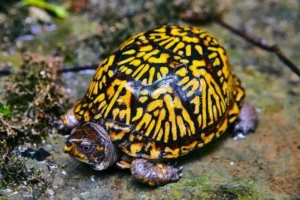13
Box turtle article by Sadiq Amin:
The box turtle is a common name for a variety of turtle species known for their ability to completely close their shells, offering them protection from predators. There are different types , but they generally belong to the genus Terrapene within the family Emydidae. Here are key details about :
1. Physical Characteristics:
- Size: They are typically small to medium-sized, ranging from 4 to 10 inches (10 to 25 cm) in length.
- Shell: They have a high-domed, hard shell with a hinged plastron (the underside of the shell), which allows them to completely close their shell when threatened. This is their key defensive feature.
- Coloration: Their shells are usually brown or olive with yellow, orange, or red markings. These markings can vary widely between individuals and species.
- Head and Limbs: They have a relatively small head, often with colorful markings, and short, sturdy legs. Their feet are adapted for walking on land, with rough, scaly skin.

2. Species:
- Some well-known species include:
- Eastern Box Turtle (Terrapene carolina carolina)
- Three-toed Box Turtle (Terrapene carolina triunguis)
- Gulf Coast Box Turtle (Terrapene carolina major)
- Desert Box Turtle (Terrapene ornata)
3. Habitat:
- Range: They are found in North America, specifically in the United States, from the eastern part of the country to the Midwest, and down into Mexico. The Desert Box Turtle, however, is found in the southwestern United States.
- Environment: They typically live in forests, grasslands, wetlands, and savannas. They prefer environments with abundant vegetation and places to hide.
-
4.Ecological role
-
Th play a role in the food web by controlling prey populations and serving as food for predators. They also help disperse seeds.If you want to learn briefly vist site.
. Diet:
- They are omnivores, meaning they eat a variety of plant and animal matter. Their diet can include:
- Fruits and berries
- Mushrooms
- Grasses and leaves
- Insects
- Earthworms and small amphibians
- They are opportunistic feeders and will eat whatever they can find in their environment.
6. Behavior:
- Slow Movers: They are relatively slow-moving creatures. They are not known for their speed, but they are excellent at finding food and hiding from predators.
- Territorial: They can be territorial and may not tolerate other turtles in their vicinity, especially during breeding season.
- Hibernation: In colder climates, They may hibernate in the winter, burying themselves in the mud or soil to survive the cold months.

7. Reproduction:
- Mating: They have a complex courtship and mating behavior, often involving elaborate displays where males may chase females or use their heads and shells to push or nudge a female into mating.
- Eggs: Female turtles lay 3 to 8 eggs, typically in a burrow or small hole they dig. The eggs hatch after 60 to 90 days, depending on the temperature. Hatchlings are independent immediately after hatching.
8. Conservation Status:
- Many species of these turtles are facing threats due to habitat destruction, road mortality, illegal collection for the pet trade, and climate change. The Eastern Box Turtle, for example, is considered vulnerable in some areas due to these factors.
- Conservation efforts are focused on habitat protection, roadside barriers, and education about responsible pet ownership.
9. Lifespan:
- They are long-lived animals, often living 30 to 40 years in the wild. Some individuals can live even longer, with reports of captive box turtles living over 100 years.
10. Interesting Facts:
- They can breathe through their cloaca (the opening at the rear of their body that serves multiple functions), allowing them to survive underwater for short periods.
- They can live both on land and in shallow water, though they are predominantly terrestrial.
These turtles are fascinating creatures, with a unique adaptation that helps them survive in the wild, and they play an important role in their ecosystems by controlling insect populations and spreading plant seeds.
Explore another pet known for its unique fins The Betta Fish.